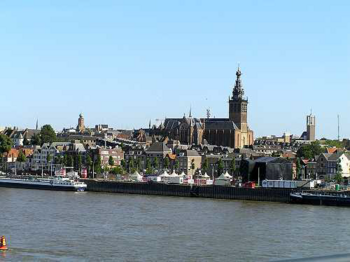Nijmegen: Difference between revisions
imported>Paul Wormer No edit summary |
imported>Paul Wormer m (wikilink to Waal) |
||
| Line 1: | Line 1: | ||
{{subpages}} | {{subpages}} | ||
'''Nijmegen''' (German: '''Nimwegen''', French: '''Nimègue''') is a city in the east of the [[Netherlands]] in the province of [[Gelderland]], 6 km (4 miles) west of the [[Germany|German]] border and 16 km (10 miles) south of [[Arnhem]]. Nijmegen and [[Maastricht]] are in competition for being the oldest city in the Netherlands, both date back to Roman times (ca. 100 AD). Until recently Nijmegen was situated solely on the south bank of the river [[Waal]], the main branch of the [[Rhine]], but since 2004 it is extending to the north of the Waal, the so-called Waalsprong. On 1/1/2009 the city had 162,000 inhabitants. | '''Nijmegen''' (German: '''Nimwegen''', French: '''Nimègue''') is a city in the east of the [[Netherlands]] in the province of [[Gelderland]], 6 km (4 miles) west of the [[Germany|German]] border and 16 km (10 miles) south of [[Arnhem]]. Nijmegen and [[Maastricht]] are in competition for being the oldest city in the Netherlands, both date back to Roman times (ca. 100 AD). Until recently Nijmegen was situated solely on the south bank of the river [[Waal (river)|Waal]], the main branch of the [[Rhine]], but since 2004 it is extending to the north of the Waal, the so-called Waalsprong. On 1/1/2009 the city had 162,000 inhabitants. | ||
{{Image|Nijmegen.png|right|350px|View of Nijmegen from the Waal river. In the background the 13th century Stevenskerk}} | {{Image|Nijmegen.png|right|350px|View of Nijmegen from the Waal river. In the background the 13th century Stevenskerk}} | ||
Revision as of 10:17, 26 March 2010
Nijmegen (German: Nimwegen, French: Nimègue) is a city in the east of the Netherlands in the province of Gelderland, 6 km (4 miles) west of the German border and 16 km (10 miles) south of Arnhem. Nijmegen and Maastricht are in competition for being the oldest city in the Netherlands, both date back to Roman times (ca. 100 AD). Until recently Nijmegen was situated solely on the south bank of the river Waal, the main branch of the Rhine, but since 2004 it is extending to the north of the Waal, the so-called Waalsprong. On 1/1/2009 the city had 162,000 inhabitants.
The city hosts a university, previously called Catholic University, that on 1 September 2004 was renamed to Radboud University, after one of the first bishops of Utrecht, Saint Radboud (ca. 850–917). The university has about 17,000 students and the following faculties/graduate schools: Philosophy; Languages; Management; Mathematics, Natural and Computer Science; Law; Theology and Religious Studies; Social Science and Psychology; Medical School and University Hospital.
Highlights in Nijmegen's history are:
- Market rights were granted by the Roman Emperor Traianus (ca. 100); the town then called Noviomagus (which means New Market).
- In 1230 the city (then called Numaga) was given town charter by Roman Emperor-Elect Henry VII.
- Negotiations between European powers took place in Nijmegen in 1678–1679, which led to the Treaty of Nijmegen.
- For many centuries Nijmegen was a fortified city, but in 1874 it was realized that city walls were not functional in modern warfare and the walls were taken down. The city was allowed to extend to the west and the south.
- In 1923 the Catholic University was founded.
- On February 22, 1944 Nijmegen was bombed by the United States Army Air Force leading to about 750 dead and many wounded.
